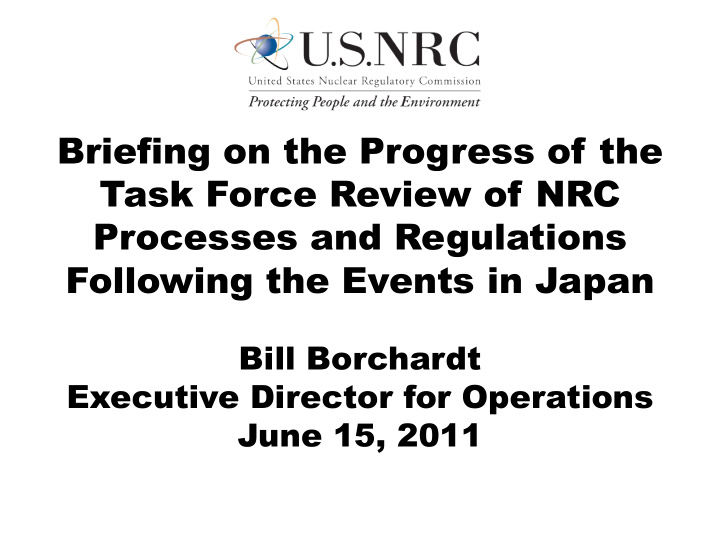



Briefing on the Progress of the Task Force Review of NRC Processes and Regulations Following the Events in Japan Bill Borchardt Executive Director for Operations June 15, 2011
Agenda • Actions to Date Martin Virgilio • Task Force Activities Dr. Charles Miller
Actions to Date • Results of Temporary Instructions (TIs) • Bulletin 2011-01, “Mitigating Strategies” • Continued international interactions 3
Task Force Activities 60-Day Update Dr. Charles L. Miller, Lead NRC Task Force
Task Force Actions Since Last Meeting • Continued task force discussions with NRC staff on technical topics • Site visits • Developing background and evaluation of focus areas • Reviewing results of TIs • Reviewing input from various stakeholders 5
Areas of Focus • Using defense-in-depth approach – Protection from natural phenomena – Mitigation for long-term station blackout (SBO) – Emergency preparedness (EP) • NRC programs 6
Themes • Protection of equipment from the appropriate external hazards is a key foundation of safety • Mitigation equipment and strategies that prevent core or spent fuel damage provide additional defense-in-depth 7
Themes (Cont’d) • EP provides further defense-in- depth by minimizing public dose should radiological releases occur • Principles of Good Regulation promote a consistent, coherent, and reliable regulatory framework 8
Protecting Safety Equipment From Natural Phenomena • Protection of equipment from the appropriate external hazards is a key foundation of safety • Rules and guidance have evolved – State of knowledge of hazards – State of the art of analysis methods 9
Protection From Natural Phenomena (Cont’d) • Plants have different licensing bases and associated safety margins • Regulatory initiatives to address vulnerabilities – Plant specific actions have enhanced margins without necessarily changing the design basis external hazards 10
Mitigating Long-Term Station Blackout • Mitigation equipment and strategies that prevent core or spent fuel damage provide additional defense-in-depth • Long-term SBO – Requires multiple concurrent equipment failures – Can result from beyond design basis external events 11
Coping with SBO • Current requirements do not address common cause failure of all onsite and offsite AC power sources and distribution • Current coping requirement assumes near-term restoration of AC power 12
10 CFR 50.54(hh)(2) • 10 CFR 50.54(hh)(2) requires mitigation capability for large fires and explosions • Capability could be useful for other events such as long-term SBO, if available 13
Availability of 10 CFR 50.54(hh)(2) Equipment • NRC inspections revealed deficiencies in: – Maintenance/availability of equipment – Procedures – Training • Equipment may not be protected for other initiating events 14
Severe Accident Management Guidelines (SAMGs) • SAMGs address plant response during a severe accident to: – Terminate core damage progression – Maintain containment integrity – Minimize radioactive releases • Spent fuel cooling not included • SAMGs were implemented as a voluntary initiative in the 1990s 15
Status of SAMGs • NRC inspection: – Confirmed that every site has SAMGs – Revealed inconsistent implementation • Procedure availability and control • Plant configuration control • Training and exercises 16
Hardened Vents • Provided to protect BWR Mark I containments from overpressure during a severe accident • Implemented at all Mark I plants following Generic Letter 89-16 • Not included in regulations • Plant-specific designs varied 17
Emergency Preparedness • EP provides further defense-in- depth by minimizing public dose should radiological releases occur • Existing EP requirements focus on single-unit events – Staffing, facilities, equipment, dose projection capability 18
Emergency Preparedness (Cont’d) • Challenges during long-term SBO – Emergency notification – Communication – Data transmission • Public and decision maker knowledge of radiation safety principles 19
NRC Programs • Principles of Good Regulation promote a consistent, coherent, and reliable regulatory framework • Past agency decisions for beyond design basis events have led to variability in licensee and NRC programs 20
NRC Programs (Cont’d) • Regulatory analysis guidelines do not provide sufficient clarity for balancing cost/benefit and defense-in-depth considerations • Voluntary initiatives have limited regulatory treatment 21
Next Steps • Near-term task force will recommend actions and topics for longer-term review • Task force report will be provided to Commission in July in a notation vote paper • July 19, 2011 Commission meeting 22
Longer-Term Review Approach • Longer-term task force to be chartered • Will address areas identified by near-term task force • Applicability of lessons to other licensed facilities • Engage internal and external stakeholders 23
Acronym List • AC – Alternating Current • BWR – Boiling Water Reactor • EP – Emergency Preparedness • NRC – Nuclear Regulatory Commission 24
Acronym List (Cont’d) • SAMG – Severe Accident Management Guideline • SBO – Station Blackout • TI – Temporary Instruction 25
Recommend
More recommend